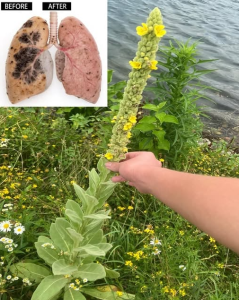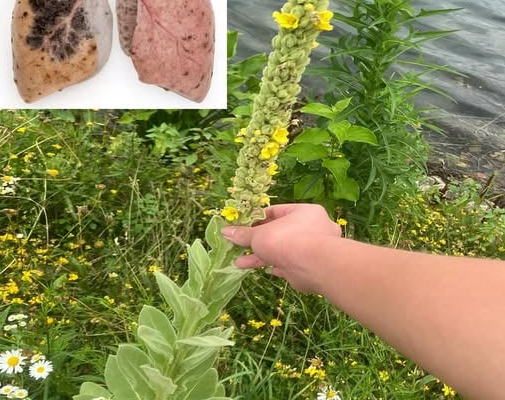Mullein: The Wild Plant That Clears Your Lungs Naturally
For centuries, humans have looked to nature for remedies to their ailments. Long before pharmacies lined city streets, people turned to fields, forests, and meadows for healing plants. Among the many treasures that grow in the wild, one stands tall—literally and figuratively. Known for its towering stalks, soft leaves, and golden-yellow flowers, mullein has earned a reputation as one of nature’s most reliable allies for respiratory health.
Often overlooked as just another “weed,” mullein is, in fact, a plant with a rich history of medicinal use, particularly for clearing the lungs and soothing coughs. In a world where pollution, smoking, and modern stress weigh heavily on our respiratory systems, mullein feels more relevant than ever.
What Is Mullein?
Mullein (Verbascum thapsus) is a biennial plant, meaning it completes its life cycle over two years. In the first year, it grows a rosette of velvety, gray-green leaves close to the ground. By the second year, it shoots up a dramatic stalk that can reach over six feet in height, crowned with clusters of small, bright yellow flowers.
Native to Europe, Asia, and Africa, mullein has since spread worldwide. It thrives in poor soil, along roadsides, and in open fields, making it one of the most accessible herbal remedies for foragers and herbalists alike. Its resilience is symbolic: a hardy plant that continues to grow and thrive where other plants might struggle—just as it helps the human body adapt and recover from stress on the lungs.
Traditional Uses Across Cultures
Mullein has a long history in folk medicine. Ancient Greek physicians praised its use for respiratory complaints, while Native American tribes burned its dried leaves in ceremonies or smoked them to relieve asthma and coughs. In Europe, mullein tea became a staple for colds, while the flowers were often infused in oil to soothe earaches.
The plant also carried spiritual significance. Some cultures believed mullein stalks could ward off evil spirits when burned like torches, earning it the nickname “candlewick plant.” In fact, its dried stems were sometimes dipped in tallow and used as makeshift candles during the Middle Ages.
But above all else, mullein’s reputation rested on its ability to bring relief to the lungs.
How Mullein Works in the Lungs
The key to mullein’s respiratory benefits lies in its mucilage content—a sticky, gel-like substance that coats and soothes irritated mucous membranes. When consumed as a tea, tincture, or syrup, mullein can calm inflamed airways and reduce coughing.
Mullein is also considered an expectorant, meaning it helps the body expel mucus. Instead of merely suppressing a cough, it works with the body to clear out phlegm, leaving the lungs cleaner and breathing easier. This dual action—soothing irritation while clearing congestion—makes it particularly effective for:
-
Chronic coughs
-
Bronchitis
-
Asthma flare-ups
-
Respiratory infections
-
Smoke or pollution-related irritation
Smokers and those recovering from smoking often turn to mullein as part of their lung-cleansing routine. It is not a miracle cure, but rather a gentle, supportive herb that helps the lungs do what they were designed to do: breathe freely.
How to Use Mullein
There are several ways to use mullein safely and effectively:
-
Mullein Tea
-
The most common preparation. Dried mullein leaves are steeped in hot water for 10–15 minutes. Because of the plant’s tiny hairs, it’s best to strain the tea through a fine cloth or paper filter to avoid throat irritation.
-
-
Mullein Tincture
-
A concentrated liquid extract, often taken by dropper. Useful for people who prefer quick and potent doses.
-
-
Mullein Syrup
-
Made by combining mullein tea with honey. This soothing syrup is especially popular for persistent coughs.
-
-
Mullein Oil
-
The flowers infused in oil create a traditional remedy for earaches and infections.
-
-
Mullein Smoke
-
Though it may sound counterintuitive, mullein has historically been smoked or vaporized to open the airways and ease asthma attacks. Today, herbalists advise using safer preparations like tea or tincture, but the tradition demonstrates how deeply mullein has been tied to respiratory relief.
-
Mullein in Modern Times
Today, interest in mullein is rising again. As people look for natural ways to strengthen their health, especially after the global respiratory concerns of recent years, herbs like mullein offer an appealing alternative or complement to conventional medicine.
Herbal companies now include mullein in teas, capsules, and cough syrups sold worldwide. Meanwhile, foragers and home herbalists continue to gather wild mullein, drying its leaves for winter use. The plant’s presence in both modern wellness shops and rural meadows reflects its timeless role in human health.
Safety and Precautions
While mullein is considered safe for most people, there are a few precautions:
-
Always strain teas carefully, as the fine hairs on the leaves can cause throat irritation.
-
Pregnant or breastfeeding women should consult a healthcare professional before use.
-
People with severe or chronic lung conditions should view mullein as supportive, not as a replacement for prescribed medications.
As with any herb, it’s wise to use mullein in moderation and listen to your body’s response.
The Symbolism of Mullein
Beyond its medicinal qualities, mullein carries symbolism that resonates today. It grows in unlikely places—cracks in the pavement, abandoned lots, rocky hillsides—yet it thrives. In many ways, it mirrors the resilience of the human spirit, especially those struggling with their breath. To breathe freely is to live fully, and mullein’s gift is to remind us of that connection.
In folklore, the tall mullein stalk was a guidepost for travelers, visible from far away. In a similar sense, mullein continues to guide modern seekers toward natural healing and balance.
A Breath of Hope
Imagine holding a warm cup of mullein tea on a cold evening. The steam rises, carrying with it the earthy scent of the leaves. With each sip, your throat feels soothed, your lungs feel lighter, and your chest loosens just a bit. This simple ritual—ancient, natural, and humble—connects you to generations before you who turned to the same plant in times of need.
Mullein doesn’t promise miracles. What it does promise is support, comfort, and the gentle reminder that sometimes the most powerful medicine grows quietly at the edge of a field.
Final Thoughts
In today’s fast-paced, chemically saturated world, it is easy to dismiss the power of wild plants. But mullein stands as a testament to nature’s wisdom. Whether you are recovering from a cough, seeking to detox your lungs after years of smoking, or simply wanting to care for your respiratory health, mullein offers a gentle, time-tested solution.
So the next time you see a tall, golden stalk rising by the roadside, don’t overlook it. That’s mullein—nature’s own lung cleanser, standing tall, waiting patiently, and reminding us that healing doesn’t always come from a bottle, but often from the earth beneath our feet.


